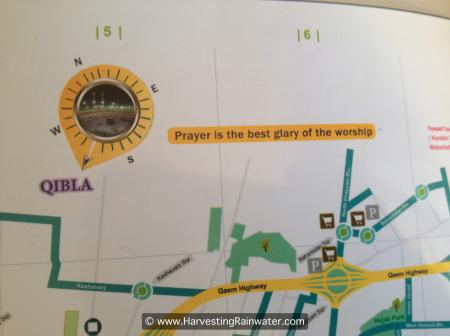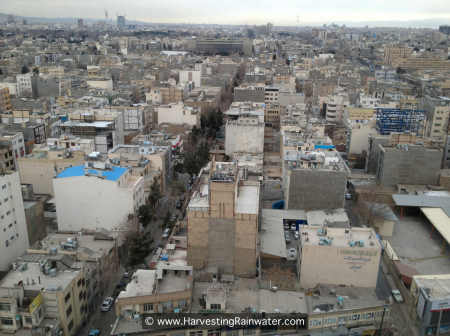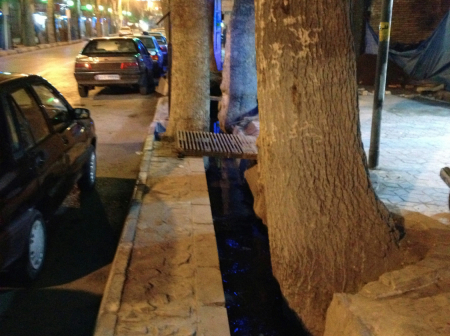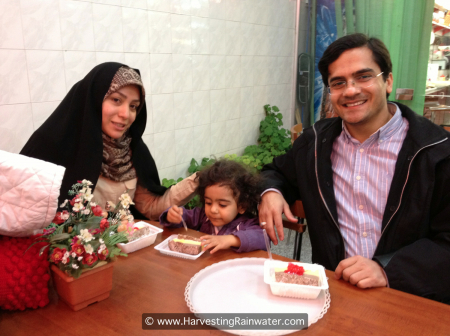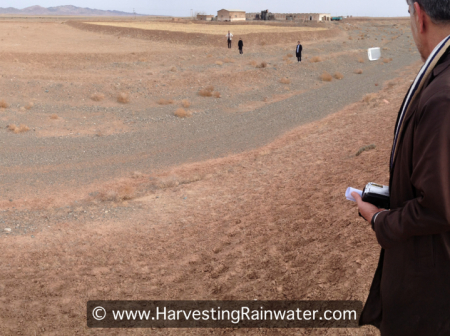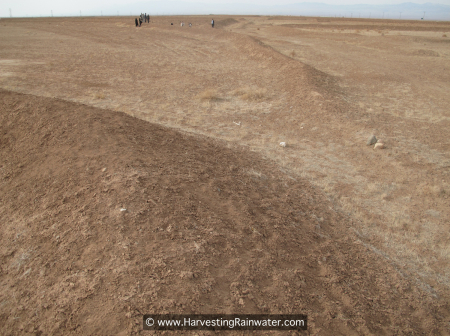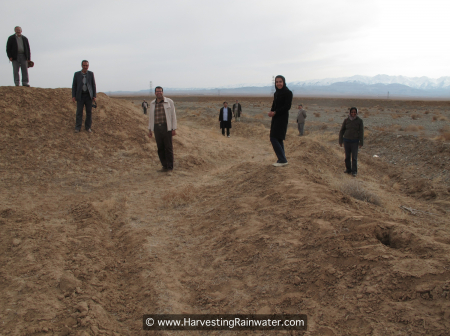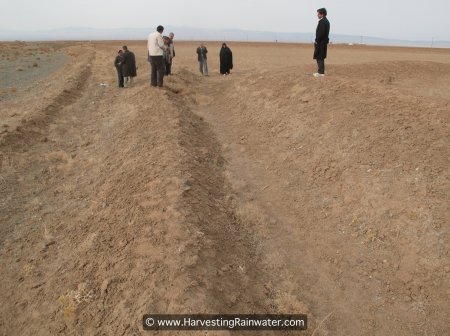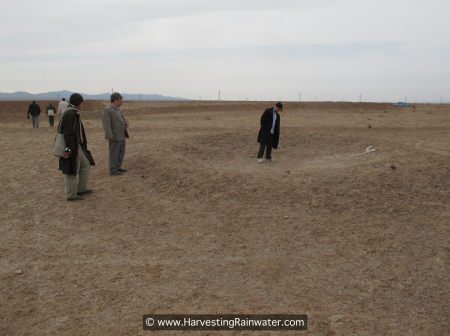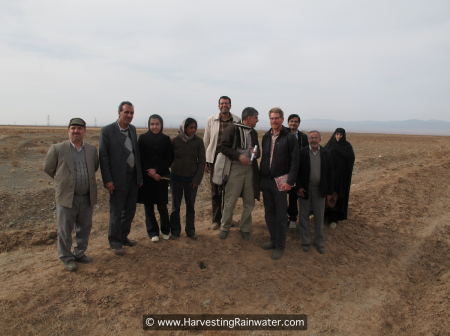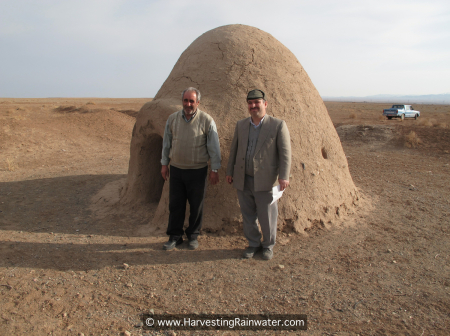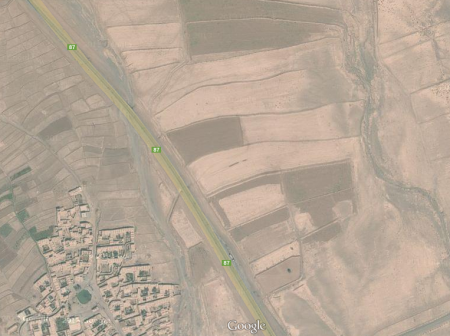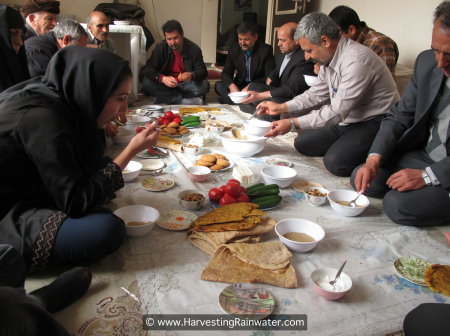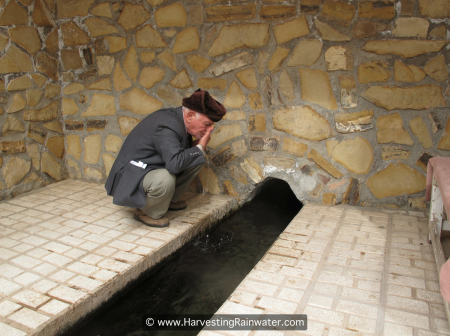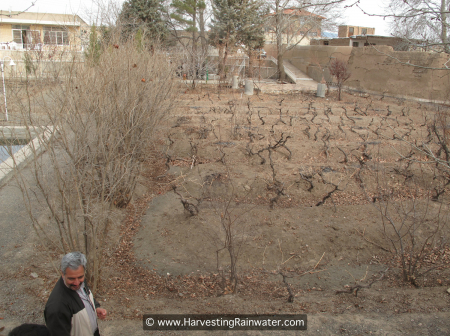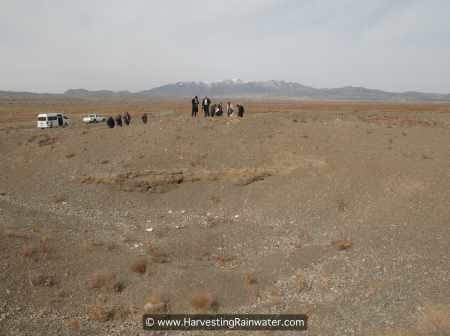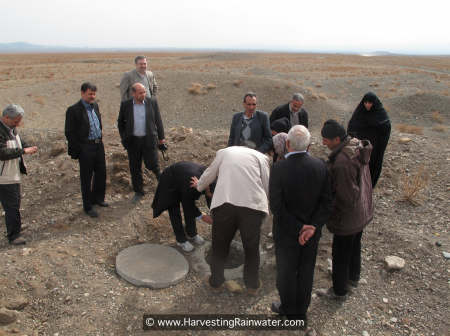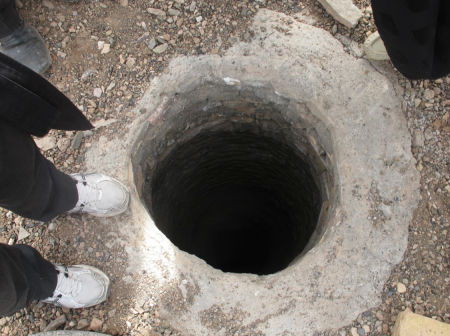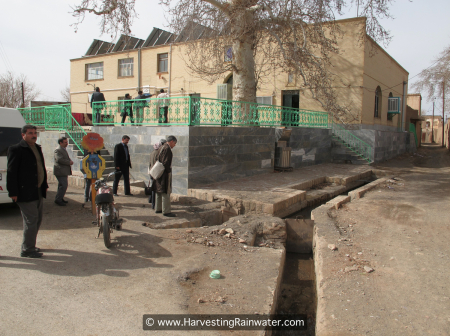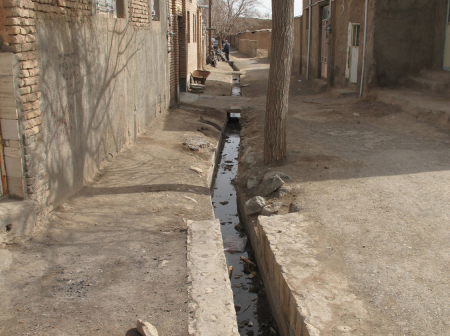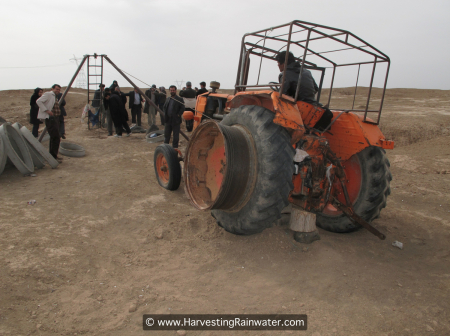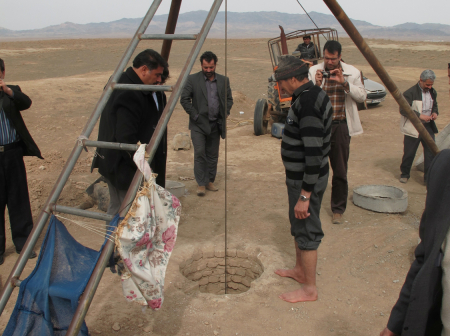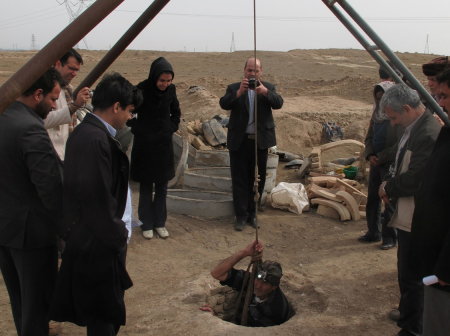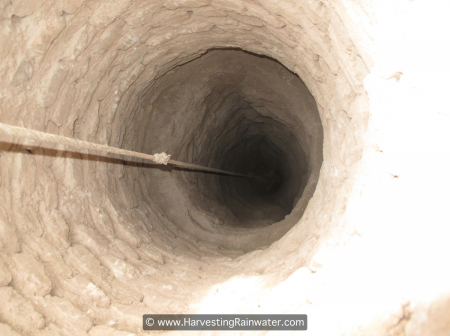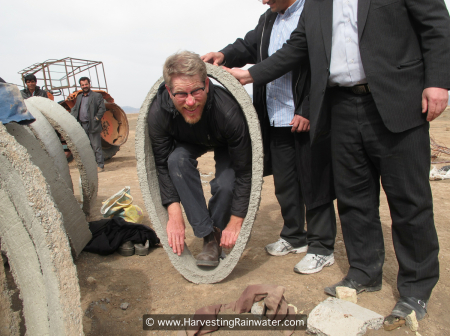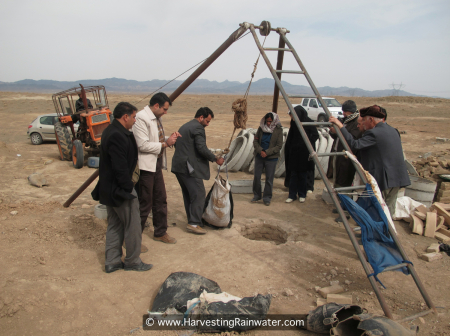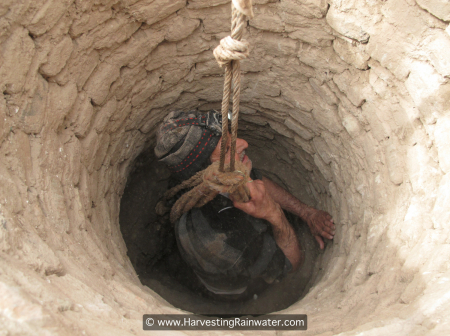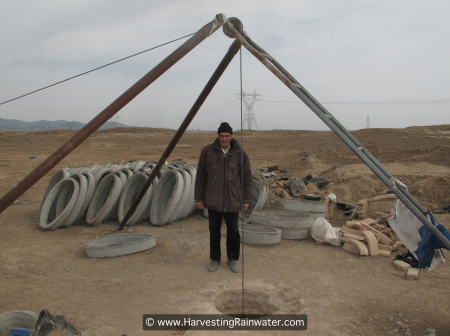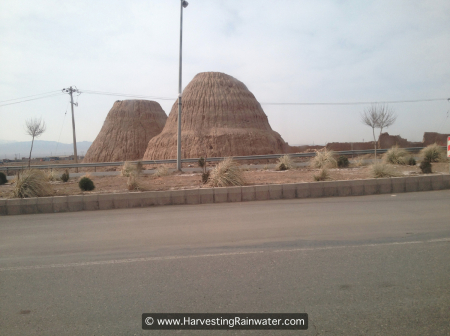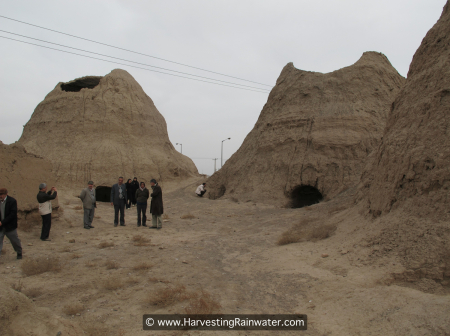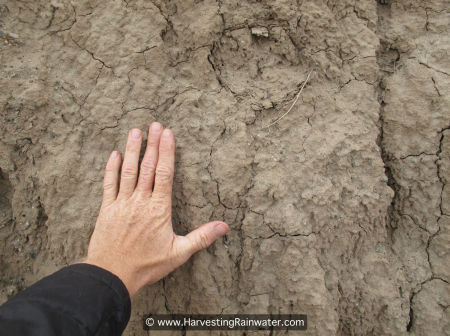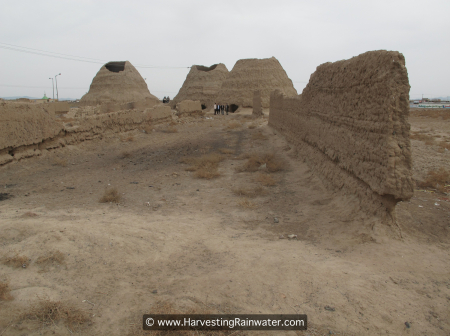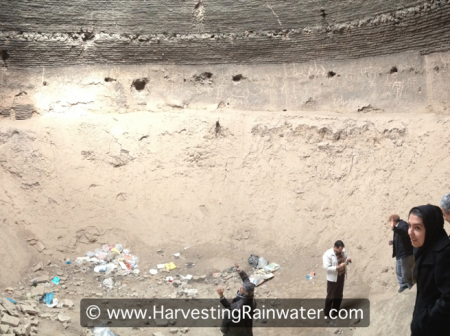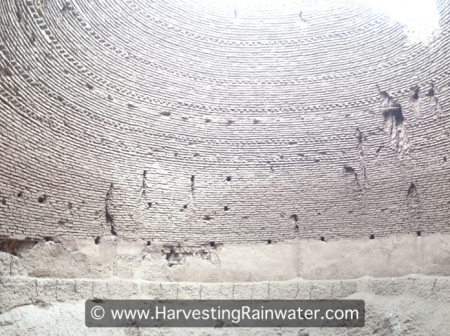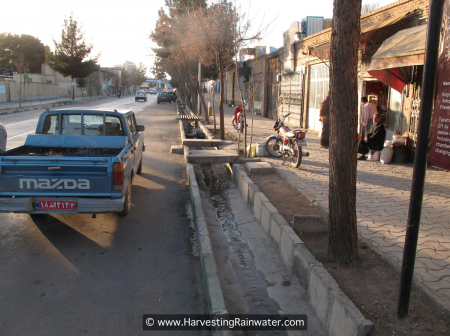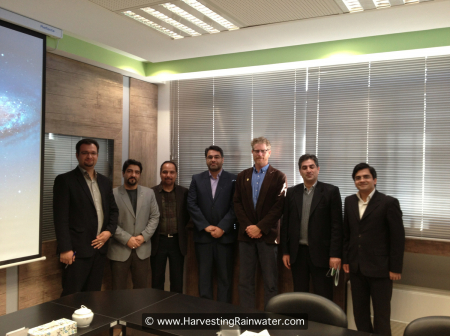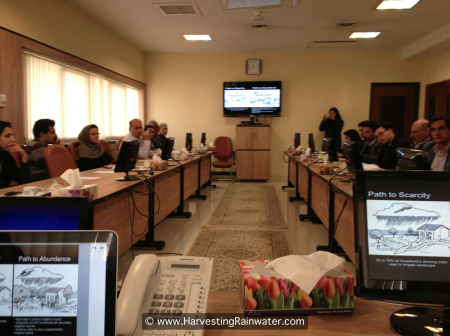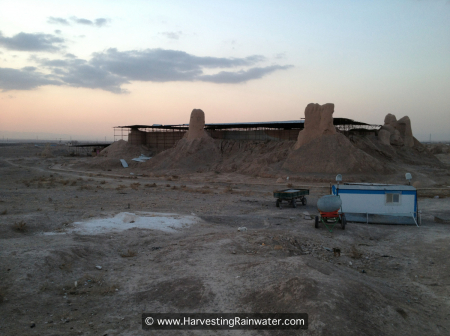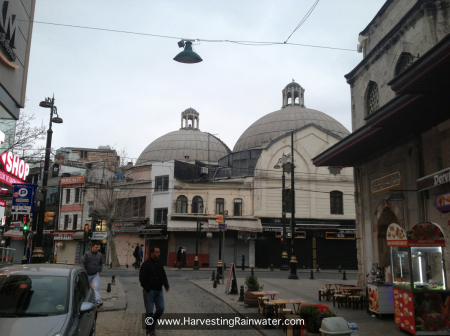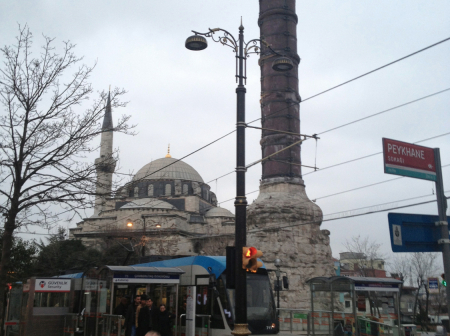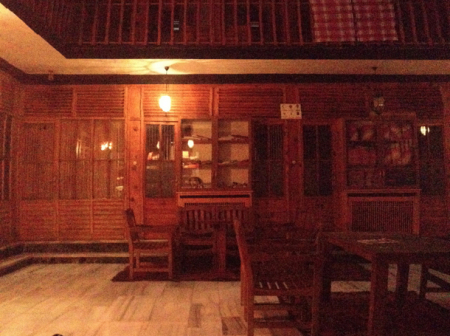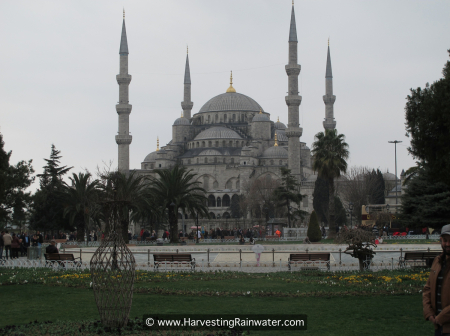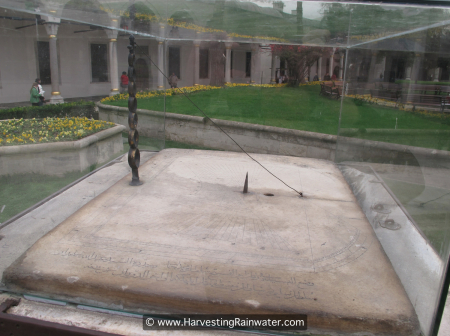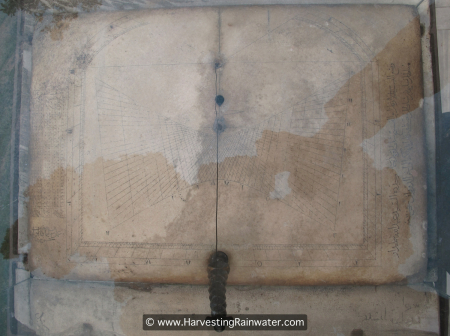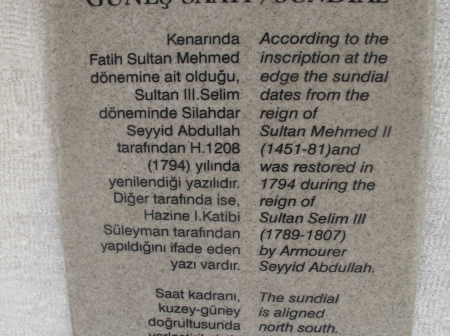My Trip to Iran by Invitation of the Iranian Rainwater Catchment Systems Association
Another incredible opportunity to share ideas, traditions, and innovations across borders within similar climates
by Brad Lancaster © 2014
www.HarvestingRainwater.com
Los Angeles, California
The February 2014 trip began with a bike ride. (My preference is to ride my bike to the airport, or walk to the bus or train station, to get some last-minute exercise, at the same time reducing a fraction of the large carbon skidmark of fossil-fuel-based travel.) I then spent my seven-hour layover well in the diversity of Los Angeles. After landing I headed straight for Wi Spa, a Korean bathhouse open 24/7 in downtown L.A. I was exhausted from working too hard, and I needed to relax prior to 20+ hours of additional travel. The hot and cold waters, steam room, and scrubbing were wonderful for this, but the best was the huge co-ed floor filled with Korean families hanging out, laughing, relaxing, conversing, reading comic books, and eating. The Korean restaurant there was amazing, and I ate together with everyone else. All of us were wearing the same spa shorts and shirts, hair wet from perspiration or bathing. It was a uniform of sorts for one big family. Before and after eating I covered myself in either salt or clay balls—both located in separate hot rooms where people can sleep, meditate, or watch Korean soap operas while digesting their food. I was reborn.
I stepped out of the spa into the surrounding Latin American district. Spanish signs and conversation were everywhere. I got a taxi—the driver was from Bangladesh. Wonderful conversation followed comparing and contrasting cultures and place.
I flew to Iran via Istanbul on Turkish airlines, which I find far superior to any American airline—more comfortable, more caring, and offering better food and movies (including lots of great international films, though I also watched Superman, from which I took a message of hope and striving for a higher purpose).
Mashhad, Iran
I arrived in Mashhad, Iran, at 2:15 am. Women in the plane now wore head scarves, whereas before I fell asleep on the plane they had not. I was met by Salman Tabatabai, a very independent-minded and intelligent young man who would be one of my main guides and hosts. As we drove from the airport, he started educating me immediately on life in Iran—for which I was grateful.
Iran is a water-traffic country. By that I mean that traffic lanes are meaningless. Vehicles stop, start, swerve, and flow like rapids in ways that seem to be without order, but the more time you spend in the flow, the more you learn to swim.
Connection to the sun and community direction
Once at my hotel I fell right to sleep. I awoke with the sun and the accompanying call to prayer—one of three prayers per day, rather than five as I’ve experienced elsewhere in the Middle East. Iranians are predominantly Shi’a Muslims, and their daily prayers are directly tied to the sun. Prayer is from dawn to sunrise, solar noon to sunset, and sunset to the next day’s dawn. Sundials/gnomons at mosques pinpoint the exact time for the midday prayer to begin. I loved this!
The Iranian connection to the sun struck me as stronger than ours—although still not perfect. In addition to this connection being manifested in the traditions of prayer, the majority of buildings in Mashhad are oriented along more or less east-west streets. The buildings are separated by courtyards to allow more light into the windows—direct southern, winter-heat-giving light as well as indirect northern light. (Though a more-exact east-west orientation of streets and buildings; equator-facing window overhangs sized to let in winter heat and light, while shading out summer sun; and more-complete solar rights planning and zoning would further enhance performance—see the new third edition of my Volume 1 for how to best incorporate these and other passive solar strategies.)
I was impressed that maintaining some winter-sun access for most buildings appears to have been intentional in the layout of Mashhad’s streets and buildings, but was later shocked to discover what had been demolished to create this pattern. Upon returning home and doing some post-trip research, I came upon a website where you can scroll down to see some photos of Mashhad around the Shrine before much of the old city was torn down in the 1960s and later rebuilt. I don’t understand this demolishing of history, and we’ve done it in my hometown, too, also in the 1960s when Tucson tore down the majority of Barrio Viejo and its wonderful earthen buildings. (To read more on this check out Kydia R. Otero’s book “La Calle: Spatial Conflict and Urban Renewal in a Southwest City.”)
On the wall of every hotel room in Mashhad (and on every map) is a sign indicating the cardinal directions and the direction of Kaaba, toward which Muslims must face when praying. I imagined all praying Muslims facing toward the same point multiple times daily, and felt it to be a very powerful uniting action and image.
So when I asked Salman how aware the average Iranian is of cardinal directions and the path of the sun, it was no wonder that he responded the awareness is high. But, as seems to be the case almost everywhere, I feel the abundance of oil has dulled the utilization of this awareness. Ever-humming and -polluting gas and electric heaters and coolers are typically turned on before a silent curtain, window, or awning is opened or drawn closed.
Notes on conditions in Iran
My first day in country, I met with a number of professors to learn more about Iran and Mashhad. Interestingly, despite the political tension between our two countries, the vast majority of them had done their graduate studies in the United States.
For a One-Page Place Assessment of Mashhad see www.
The following bits of information came from notes I took on my trip:
• There are 3 million residents in Mashhad, but up to 22 million visitors a year—most of whom are on a pilgrimage to visit the exquisite shrine of Iman Reza.
• Groundwater is being extracted in Iran at a rate exceeding natural recharge by about 10 billion cubic meters per year.
• The traditional means of accessing groundwater is with qanats. These are near-level hand-dug tunnels often many kilometers long, which bring water from a (typically hand-dug) well at the base of a mountain out to the more fertile valley below. Gravity alone moves this water—no pumps. Thus extraction is automatically kept in check. When water levels in the well drop, so does flow, and thus also use of water from the qanat. Therefore overextraction of groundwater does not occur via qanats.
• There are over 62,000 qanats in Iran, but since mechanical pumps have been introduced, 20,000 or 40,000 of these qanats (my notes are not clear on which of these two numbers is correct) have gone dry. This is due to new wells that have been dug and fitted with mechanical pumps near the source-well for the qanats. The mechanical pumps never stop or slow their pumping, and they lower the level of the groundwater to such an extent that the groundwater drops below the level of the qanat’s tunnel, thereby ceasing its flow.
• Wells average 100 meters deep, but some are as much as 300 meters deep. Groundwater levels are dropping 1 meter or more per year. Salinity levels of the water are increasing.
• There are almost as many illegal wells as legal wells. Monitoring and metering of wells is only just beginning.
• 10 meters of subsidence has occurred in areas around Mashhad due to the overconsumption of groundwater.
• Lakes such as Urmia are drying up (half of lake has dried up in last decade). Rivers such as Zayandeh Rood are going dry. Airborne dust is becoming more of an air-quality issue.
• Wet years are more damaging than dry years since people are more accustomed to drought than flooding, thus when big storms come flooding and erosion can be severe.
• 12 billion cubic meters of water are imported into Iran each year—much of which is pumped uphill, consuming more power and water (6 billion cubic meters of water a year is used in thermoelectric power plants). At the same time an equal amount is lost to runoff and evaporation.
• 36% of all energy in Iran is used to pump water—primarily for agriculture. 60% of that energy consumption is to extract groundwater.
• 1 million hectares of land—10% of the cultivated land in Iran—are watered with pressurized irrigation.
• High-water-use crops could be switched out in favor of lower-water-use crops. Flood irrigation could be switched to drip irrigation.
• 73% of water withdrawls are for agriculture. 20% for urban use and industry.
• 20% of water in Mashhad is used for green spaces. 20–30% of this is drinking water emitted directly into the soil for irrigation of landscapes. The rest of the water for green spaces is from wells.
• The water-consumption footprint of the average Iranian is 350 liters/person/day (similar to the American average). The world average is 250 liters/person/day.
• 21 billion m3 of virtual water is imported into Iran each year.
(Also see Wikipedia: en.wikipedia.org/wiki/
The water challenges in Iran are not unique. Most are similar to those found in drylands (and even some wetter lands) around the world.
The IRCSA water-harvesting conference—seeking solutions
The water-harvesting conference was well attended. It was wonderful to see such interest in water harvesting, and a resurgence in the valuing of using low-cost, higher-quality on-site waters as opposed to always looking to import costly distant waters that need extensive treatment. As with all places I’ve lived or visited, Iran has a rich water-harvesting tradition that people began to abandon and forget as soon as cheap fossil-fuel energy became available. This has led to incredible wastes, inefficiencies, and—ultimately—growing water shortages as people ignore and squander what they already have for free (rain). It turns out that the amount of rain falling on Mashhad in an average year comes close to equaling all its citizens’ current consumption of municipal water (much of which comes from the Dootsi Dam project from which the water needs to be pumped uphill to Mashhad). See the Water section of the One-Page Place Assesment for Mashhad at www.
The conference began with a beautiful reading/singing of verses of the Koran relating to the rain. Poems were read between each speaker. Poems were a common theme. People recited poetry everywhere I went. It’s a wonderful way to generate a creative field and a more open mind.
Dr. Tanuja Ariyananda from Sri Lanka, past president of the International Rain Water Catchment Systems Association (IRCSA), gave the first keynote—about rainwater harvesting around the world. I gave the second later in the day. In between were many talks by Iranian researchers looking at traditional water-harvesting systems and potential new innovations, but I had a hard time following the content as the presentations were in Persian.
I focused my presentation on similarities between the situation in the U.S. and Iran, striving for living regenerative systems, and the greater potential of harvesting on-site water by integrating those harvests with other on-site resources such as the sun, shade, wind, and community. I think it went well. I ended by noting that I’d love to collaborate with others to get my book translated and published into Persian. A number of folks stepped up with offers to translate, but I’m still looking for an Iranian publisher/distributor for the book. We’ll see what happens.
Cultural faux pas
After a night or two my hosts later moved me to a 5-star hotel, though I had been fine with the more modest previous hotel. I was led to an opulent room on the 15th floor, and asked by facial expression if all was satisfactory. I could only respond in English that all was great and by giving the staff a “thumbs up” sign—a horrible mistake. I later learned that in Iran the “thumbs up” sign is like giving someone “the finger.” I felt horrible about this, and made a point not to repeat this mistake. However, I fixated on it so much I often had small jolts of panic as I imagined my thumbs trying to rise anytime things were going great—which was most of the time.
Hopefully the hotel staff likes to use Facebook, which uses the thumbs-up sign as a good thing. Facebook is banned in Iran and blocked by the government. Nonetheless it is widely used. Free filter-breaking software is easily available along with the most-current software—often becoming available on the black market before its official release. Such software also enables Iranians to bypass international blocks—due to sanctions—on websites such as Google Earth.
Situated the 15th floor of the hotel, my room had an incredible view of the city and surrounding mountains. The city is massive, and its consumptive roar is constant. As it grows, ever more water, power, food, land, etc is consumed. Planes fly in all day long every day. I awoke that night as I often do in large cities with a feeling approaching panic. How long can such consumption go on? How can we shift the direction of our lives from ever more consumption to enabling ever more life? I wrestled with these questions until dawn. Then I heard the crow of a single rooster rise from the constant hum of the city below. This rooster gave me hope. He was out there amidst a sea of pavement. He was likely not alone. Seeds were likely germinating in the cracks.
Mashhad
After the conference, Salman toured me around Mashhad. My favorite outing was our walk to and throughout the Shrine/Tomb Complex of Imam Reza. This is a major economic/spiritual/cultural engine as it is a pilgrimage site attracting nearly 20 million visitors a year. The site is exquisite, massive, and growing. Buildings at its periphery are being torn down to make room for growth, while the outermost buildings are still under construction. Upon entering, you leave the frantic rush of the city and traffic behind—even though the shrine is in the middle of the city. Inside this refuge there is a feeling of calm along with the constant flow of the cycle of life. Full-time crews continually lay out, then roll up prayer rugs for the three daily prayers—though people are praying and reading continuously. The architecture is incredible with beautiful tile mosaics, domes, engraved gold, passive-cooling features, and ceilings of complex, mind-altering mosaics of tens of thousands of mirrors.
All aspects of the shrine are regularly being cleaned by volunteers. Other volunteers in long coats keep order. Many of these volunteers are PhDs, doctors, lawyers, and such who devote at least one day a week to the shrine. When an elderly man said I should not enter the shrine as I am not a Muslim, the caretakers in the coats welcomed me in. It was explained to me that Imam Reza was known for his extreme generosity and tolerance and thus the shrine is open to all people.
The cycle of life is very present in the shrine for there is an endless flow of funeral processions bringing the dead through the shrine complex before burial. And I learned that the burial custom contains no toxic formaldehyde injections into the bodies nor lead-lined caskets (as is disturbingly often the case in the U.S.), but just the body wrapped in cloth with an airspace above to speed decomposition back into the Earth.
As we were about to leave a different long-coated volunteer approached us and said I should not be in the shrine as I am a foreigner. A discussion ensued, and we then left, as we had already been planning to do. It struck me that there is likely a continuous push and pull of different thinking among the volunteers of the shrine as there is in our greater society. Like a seesaw, tolerance and openness go up and down.
For myself, I found being initially welcomed into the shrine further opened my interest in Islam and encouraged my desire to learn more. Openness invites openness.
Next was a museum with a fascinating array of old navigation and astronomical tools.
The day was later capped with an evening visit with Salman and his family to the higher-elevation village of Torghabeh and some amazing regional ice cream full of ever-changing flavors placed atop crunchy, spaghetti-like faloodeh noodles. As with Mashhad, all streets were tree-lined, but here the trees were massive, canopying over the entire street with street runoff passively irrigating the trees.
Trip to traditional water-harvesting systems in rural Khorasan Razavi
30% of Iran is suitable for dryfarming—irrigating solely with the rain. Autumn rainfall is the key indicator of potential success. Autumn 2013 was dry, and the drought continued through winter. Crops, such as wheat, are planted after the rain. Thus I saw very little growing as the rains had not come. 1 in 5 years there is typically a severe drought. This is a severe drought year. Only 18 mm (just over 2/3 inch) of rain had fallen from the beginning of the year up to my visit on February 21.
Bandsars
Bandsars could be seen everywhere—spreading across 140 km2—as we drove along the highway from Mashhad toward Sabzevar. “Bandsar” roughly means a repeating pattern of small earthen dams. A bandsar is an ancient system for harvesting rainfall and runoff to flood-irrigate fields in flatter lands. It is brilliantly simple. Earthen berms, somewhat like those of a very large boomerang berm, or the Indian chouka system described in the Introduction of Rainwater Harvesting for Drylands and Beyond, Volume 2, hold runoff within a field. Runoff (from a catchment, from a small ephemeral waterway, or from both) is directed into the bandsar. Once the bandsar field is full of water, the harvested water either backs up to the inlet point so no more water enters the field (like the street-side curb cut basins described in chapter 8 of Rainwater Harvesting forDrylands and Beyond, Volume 2), or the field will overflow at a point on the other side of the field (nearly level with the inlet), the overflow being directed into another bandsar. The elevation of the inlet in relation to the height of the berms and the field itself are closely monitored and adjusted to ensure enough water is harvested, but not too much, so fields are not waterlogged.
As these systems act as backwater or eddy systems of collecting, settling, and infiltrating water—as opposed to flow-through systems—they are less prone to erosion. Villagers position themselves in their fields during storms and runoff-water flow, and are quick to fix any problems should they arise. Rodent burrows in the earthen berms can lead to blowouts if not watched. Earth and brush or weeds are used to plug holes or redirect flows. Incoming sediment is spread out on the fields or used to reinforce the bandsars’ berms. This inflow of sediment is also an inflow of fertility, so no additional fertilizer is needed. Only on-site materials are used. Nothing is imported. Nothing needs to be bought for the system to work.
On average there will be 4–5 rainfall events per year with enough rain running off to be harvested. Crops are planted after a runoff event, not before.
Soil moisture from harvested cool-season runoff typically lingers in bandsar fields for 2 months. Wheat, barley, and melons are dryfarmed in these fields. In this dry area, runoff-irrigated bandsars typically do not support fruit or nut trees unless there is some supplemental water (such as greywater) available for irrigation in the long summer dry season.
During the growing season farmers will live in earthen structures within the field to scare off wildlife that might attempt to eat the crops. Livestock freely roam the fields in the off-season as the fields are then considered common grazing land. During the growing season scarecrows are constructed to alert shepherds to keep their livestock away.
On a satellite image of Google Maps or Google Earth, search for Soqeyh, Khorasan Razavi, Iran. Just outside the village are some of the bandsars I visited. If you look at the 2013 images, the bandsar fields will be fallow and brown as there was no significant winter rain, while you’ll see some smaller green fields irrigated with pumped groundwater.
Dr. Javad Tabatabaee Yazdi, my primary host, guide, and director of the water-harvesting conference, informed me that such groundwater-irrigated fields suffer from increasing salinity, rising electricity costs, the need to pay back the loans that funded the digging of their wells, and reduction in efficiency as groundwater levels drop. Fields often become too salty to grow traditional grains, thus many are switching to growing more-salt-tolerant pistachios. Nonetheless groundwater-irrigated fields are increasing, while bandsar agriculture is falling out of favor due to the current low cost of government-subsidized electricity (to power water pumps). Yet bandsar agriculture does not lead to the salinization of the soil, depletion of groundwater, or reliance on fossil fuels, fertilizer, or loans.
Qanats
These ancient water tunnels have been ideally suited to provide the lifeblood of year-round water to numerous dryland farms and villages for generations. They are subsurface canals, thus they do not lose water to evaporation as would be the case with an open-surface canal. Gravity moves the water for free, so there are no pumps or power needs. We visited a couple of qanats, one being over 1,600 years old. Near the base of a mountain 7 km away, a 220-meter well had been dug down to the water table. Then a near-level tunnel was dug from the base of the well to the village 7 km away in the plain below the mountain. (The total length of the qanat is 15 km, but much of this additional distance is in need of maintenance and clearing of debris.) Vertical vent shafts have been dug out along the entire length of the qanat to provide air for those building and maintaining the qanat as well as an exit from which dug-out material and debris could and can be removed by buckets drawn up via a rope/cable, tripod, and pulley.
There are 1,500 qanats in the area around Sabzevar, but only 800 are still in use since the water output of the others is now too low (often due to adjacent wells with mechanical pumps that are over-extracting the groundwater). The first qanat we visited outletted into a village that distributed the qanat water via canals to numerous walled homes, orchards, and vineyards.
I drank the qanat water where it first entered the village. It was delicious and needed no filtration. This was at the home of 81-year-old Sheikholeslam. He spent 40 years of his life bringing the qanat back to life, and he continuously spouts poems in praise of the qanat.
The qanat needs regular maintenance, though in poorer rural communities, Sheikholeslam said, paying for such maintenance can be a challenge, and not too many of the younger generation are learning qanat skills. Though once his qanat was maintained/cleaned, the flow increased from 40 to 220 liters per second. A local moqani, a person who digs and maintains qanats, said there are 50 teams in the region that can keep the qanats maintained if there is the money to pay them. Working time for a qanat crew is 4 to 5 hours. More time below ground is too much. The crew leader is paid a daily rate of $20 U.S. per day, while the other workers get $12–$14 U.S. per day. Or if paid per meter dug, the cost can be $5–$15 per meter depending on difficulty of the work.
Depending on soil type, a qanat can be hand-dug at a rate of 0.5–1 meter per day in bad soil or up to 5 meters per day in good soil. Clay soils are bad as they can often collapse. A soil mix of sand and clay is more stable. Less-stable soils require reinforcing rings to be installed. Traditionally these were made of fired clay, but concrete rings are becoming more common as they can be manufactured on site, and made larger than the fired-clay rings.
Cisterns used to be in every mosque and every home. These cisterns could hold qanat water and/or rainwater, but 50 years ago this practice started to be forgotten as pressurized water lines from mechanical wells started to be installed.
Yakhchals
A yakhchal is a Persian refrigerator or ice hole. We saw many of them from the highway, looking like earthen mounds or melting domes. To create a yakchal, first a pit is dug. The resulting soil is used to make unfired earthen (adobe) bricks. The bricks are then used to construct an incredible dome structure around the pit. Beside the dome, earthen brick walls are built on an east-west axis to cast the maximum amount of winter shadow on shallow ponds situated north of the walls. Qanat water is diverted into the ponds in the winter months (on average there are 60 freezing days per year in the area). The water freezes into ice, which is then collected and placed in the dome, layering straw atop each batch.
Once full, or once freezing season was over, the domes were closed up, only a small vent remaining open at the top of the dome. Two to three months later, people would start to access the ice for use in the hot months. Thus Bastani-e Za’far?ni (Persian ice cream, also called Bastani-e Akbar-Mashti or Gol-o Bolbol ice) could be enjoyed in summer, made with the ice harvested the previous winter. The ice typically lasted through the end of summer.
But all the yakhchals we saw were in serious disrepair. They stopped being used 40–50 years ago when electricity arrived and electric refrigerators became the norm. As elsewhere across the world, self-reliance is transforming into import-reliance.
Abanbars
An abanbar (ab – water, anbar – storage) is a traditional Iranian drinking-water cistern often containing harvested rainwater or qanat water. We did not have the opportunity to enter one, but we did have the opportunity to look into the entrance stairway of one in the city of Sabzevar. More on abandars can be found here.
Last day
On my last day in Iran, I gave presentations to Mashhad’s Greenspace and Public Parks Office and the local water authority. Discussions followed. It all reminded me of initial meetings with park- and water-department officials in Tucson, Arizona, 10 years ago when the water-harvesting movement here was just getting underway, and I was still writing my books. People seemed interested, but also pessimistic and uncomfortable with the challenge to do things in new ways (which are really just modern versions of old water-harvesting traditions). I figure that 10 years ago in Tucson, and then again during this trip to Mashhad, I was planting and watering thought-seeds in people’s headwaters. It takes time, but some of those seeds have germinated and grown and others will do so in the future—especially if others also share their water-harvesting/life-
The day was then capped with a visit to the tomb of Ferdowsi, author of the Shahnameh, the Persian epic responsible for a resurgence of Persian culture after 1010 CE. We also saw massive ancient earthen walls built to repel Mongol attacks from the ancient city of Toos, and discussions around Persian stories of horrendous atrocities followed by heroic acts of forgiveness by those wronged—enabling less-violent, more-life-affirming futures.
The evening was wonderful, spent in the home of Salman, wife Elham, their ever-laughing daughter Amena, and Elham’s brother (a budding actor). We enjoyed great conversation and a delicious home-made dinner of of Ghorme-Sabzi. Then I was off to catch a 3 a.m. flight to Istanbul.
In closing, I want to thank the people of Iran for being such incredibly kind and welcoming hosts. It was such an honor to be able to meet, converse, and collaborate face to face.
Istanbul, Turkey
As soon as my plane landed in Istanbul I made my way for the visa counter and then took a cab to the old city in order to make the most of my 7-hour layover. I was dropped off at dawn upon the door to the Cemberlitas Hamami, a bath house built in 1584. I walked across the street for tea and pastries where I could watch the seagulls flying about ancient domes, mosques, and the Cemberlitas column built in AD 330 to record the dedication of Constantinople (Istanbul) as capital of the Roman Empire. As I finished my breakfast the café owner then gifted me with some Turkish Delight candy.
My hunger sated, I entered the calm sanctuary of the hamam. I was greeted by a gracious elderly man in formal attire and given a tiny room with a tiny bed overlooking the central entrance dome. The room was to change in and later take a rest—perfect! I then made my way into the womb-like main dome of the bath. As I entered via a massive wooden door, the heat and humidity hit me as I looked upon a huge marble platform surrounded by graceful columns framing bath stations.
Lying upon the heated marble, I was then scrubbed and washed. Sunlight entered sun-, moon-, and star-shaped punctures in the dome roof. The heat permeated me, and I cooled off with buckets of cold water. I thought of how important it is for us to have fluctuations between hot and cold, just as it is for our planet. Such a differential gives us a reset, refreshment, and movement as it gives our planet currents, winds, seasons, and weather.
I made my way to my tiny room-sanctuary to rest and ponder. Memories arose of earlier trips to the ancient bathhouse in Nablus, Palestine; Byzantine era cisterns; and subsurface irrigation ollas—all dryland strategies beneath the protection of the earth’s surface.
I thought about how key it is to engage and to experience. The opportunity to walk the path of water in the bandsars so enriched my understanding—as has conversing across cultures. I thought about Craig Child’s writing (I just finished, and recommend, his latest book “Apocalyptic Planet”). He weaves stories around his own direct experiences. Reading about these direct experiences puts you there with him. The story is lifted from telling, to sharing, and even begins to enter engagement when you feel you are in his shoes experiencing what he is experiencing. I’m especially drawn to this because it motivates me to get out and engage.
My time in Istanbul was running out. I got a glass of freshly squeezed pomegranate juice, jotted down some thoughts, then quickly walked by the incredibly beautiful Blue Mosque, the Hippodrome, and into the Topkapi Palace (the best part of which for me was the sundial). Then it was back to the street, get some roasted chestnuts, and grab a taxi (in Istanbul cars stick to their lanes, but my taxi driver skillfully sped over 90 miles per hour) to the airport to fly to Texas to reunite with old friend Farmer Dave during another layover in Houston, Texas.
Houston, like Mashhad, is experiencing drought, which is made worse by contemporary building practices and infrastructure that drains the rain. This makes dry years drier, while worsening downstream flooding in wet years.
The potential to make things better by harvesting the rain and enabling more life is everywhere.
For more on Bandsar Water-Harvesting and Farming by my Iranian hosts, see this guest blog entry.
See the new, full-color, revised editions of Brad’s award-winning books
– available a deep discount, direct from Brad:

Volume 1


